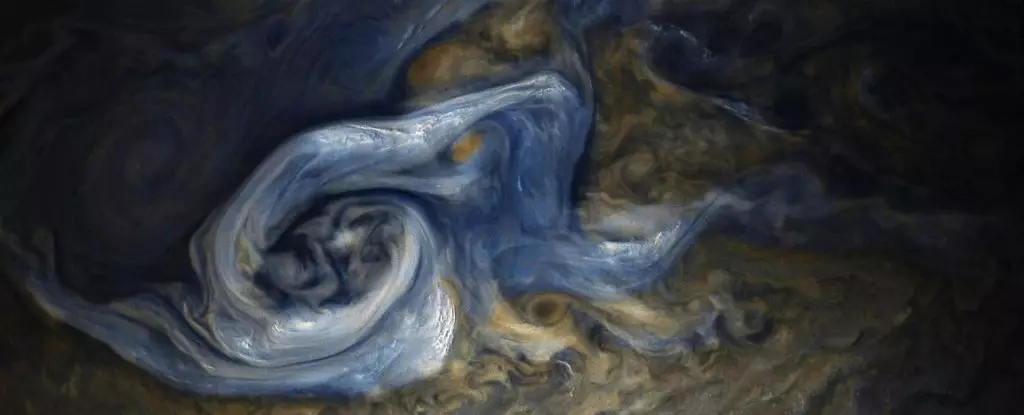Jupiter, the giant of our solar system, is renowned for its tumultuous climate and tumultuous storms, which often evoke comparisons to Earth’s own weather phenomena. However, as scientists delve deeper, they find that Jupiter’s atmosphere presents complexities far beyond our terrestrial understanding. Recent discoveries shed light on one such peculiarity: the phenomena of “mushballs”—massive aggregates of tumbling ice composed of ammonia and water that resemble slushy mixtures. These findings not only illustrate the wild, unpredictable nature of Jupiter’s weather but also challenge our existing theories about atmospheric processes on gas giants.
The Genesis of the Mushball Theory
The hypothesis of mushballs first emerged from research conducted using data from NASA’s Juno spacecraft in 2020. As the probe orbited Jupiter, it collected detailed readings during encounters with some of the planet’s most violent storms. Scientists observed unexpected interactions between water and ammonia in the upper atmospheric layers. They suggested that intense storms propelled water high into the atmosphere, combining it with ammonia vapor. This interaction results in a hybrid droplet that, under extreme cold, freezes into mushballs. The implications of this discovery are staggering; it provides a plausible explanation for the patchy ammonia distribution across not just Jupiter, but possibly other gas giants like Saturn, Uranus, and Neptune as well.
The Research Behind the Findings
To further investigate this groundbreaking hypothesis, a team led by planetary scientist Chris Moeckel at the University of California, Berkeley, collaborated with colleagues at Caltech. The researchers meticulously analyzed years of data from both Juno and the Hubble Space Telescope. Their work revealed a three-dimensional view of Jupiter’s upper atmosphere, leading to insights about the complex interplay between storms and atmospheric composition. What was once believed to be shallow weather events was now understood to be far deeper and more convoluted, demonstrating that turbulent storms could extend well beyond the cloud tops and reach depths still uncharted—up to 150 kilometers below the surface.
Determining the formation of these mushballs required validation of frenzied atmospheric activities within Jupiter. Scientists suspected that tremendous updrafts would be necessary to transport water aloft, where it could then interact with ammonia, leading to the unique conditions necessary for mushball formation. Their data indicated that these elements combine in specific ratios, reaffirming that the planet’s weather systems work together in a delicate and dramatic interplay. Each discovery begs for further exploration, suggesting that nature revels in complexity and surprise.
The Implications for Atmospheric Science
The capabilities of mushball storms to redistribute ammonia present significant implications for our understanding of atmospheric science. Traditionally, scientists struggled to account for the distribution of ammonia in Jupiter’s clouds, but with mushballs, we can begin to unlock the mystery. As these icy spheres tumble through the atmosphere, they efficiently transport ammonia into deeper layers of the atmosphere and possibly even into the planet’s interior. This transports not only essential components of the atmosphere but also alters its chemical dynamics in ways we are only beginning to grasp.
Moreover, the potential for similar mechanisms on other gas giants widens the scope of this research. If mushball-like phenomena exist beyond Jupiter, they could revolutionize our understanding of atmospheric processes across different celestial bodies. The interconnectivity of planetary atmospheres may share more similarities than we think, hinting at universal principles governing weather and climate.
The Quest for Future Discoveries
As scientists continue to decode the nuances of Jupiter’s weather, the desire for further exploration remains high. Every new observation could yield surprises and challenges, reshaping our perceptions of atmospheric phenomena across the cosmos. With advancements in observation technology, future missions may unveil more about these extraordinary weather systems and their implications for not only Jupiter but for other planets in our solar system and beyond.
In the realm of atmospheric science, where conditions differ vastly between Earth and gas giants, understanding these dynamic interactions offers insights into the foundational processes influencing fate and behavior of planetary systems. As researchers probe deeper into the mysteries of Jupiter’s mushballs, the implications could evolve our understanding in ways we cannot yet envision. Exciting times lie ahead in the continual pursuit of knowledge about the great celestial mysteries that govern our universe.

